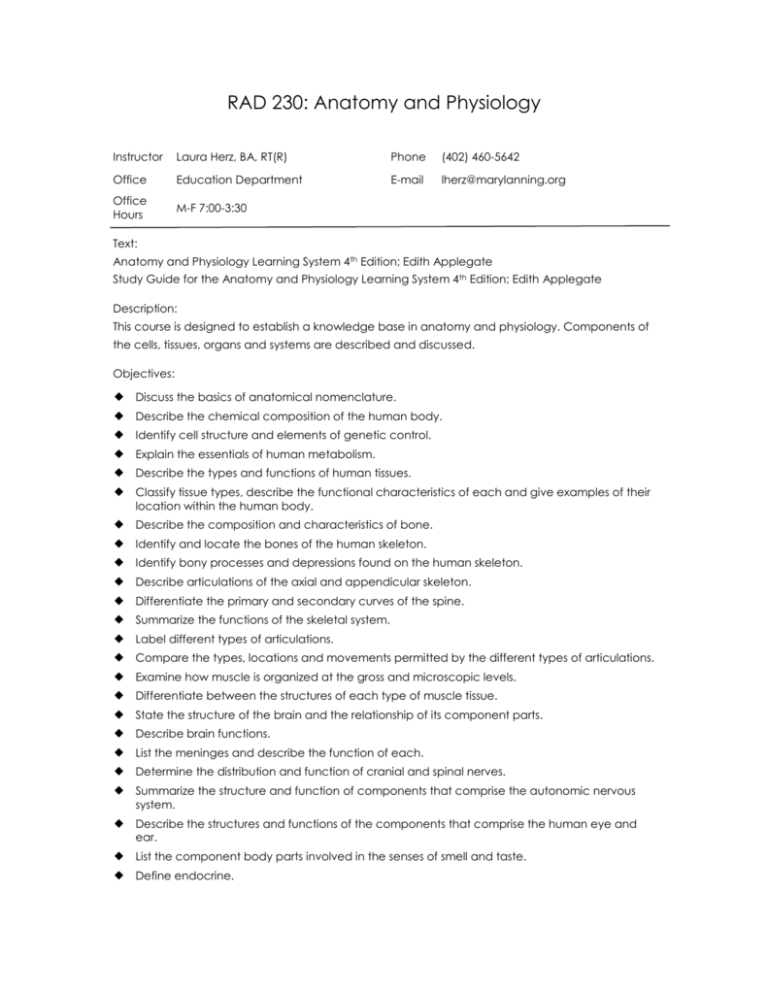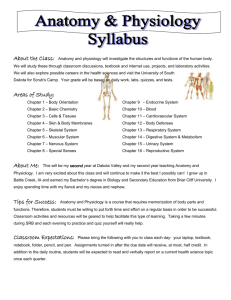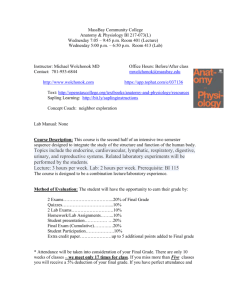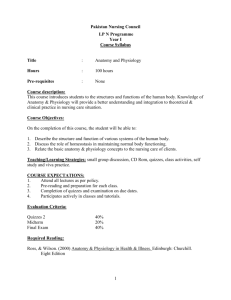Course Syllabus
advertisement

RAD 230: Anatomy and Physiology Instructor Laura Herz, BA, RT(R) Phone (402) 460-5642 Office Education Department E-mail lherz@marylanning.org Office Hours M-F 7:00-3:30 Text: Anatomy and Physiology Learning System 4th Edition; Edith Applegate Study Guide for the Anatomy and Physiology Learning System 4th Edition; Edith Applegate Description: This course is designed to establish a knowledge base in anatomy and physiology. Components of the cells, tissues, organs and systems are described and discussed. Objectives: ◆ ◆ ◆ ◆ ◆ ◆ Discuss the basics of anatomical nomenclature. ◆ ◆ ◆ ◆ ◆ ◆ ◆ ◆ ◆ ◆ ◆ ◆ ◆ ◆ ◆ Describe the composition and characteristics of bone. ◆ Describe the structures and functions of the components that comprise the human eye and ear. ◆ ◆ List the component body parts involved in the senses of smell and taste. Describe the chemical composition of the human body. Identify cell structure and elements of genetic control. Explain the essentials of human metabolism. Describe the types and functions of human tissues. Classify tissue types, describe the functional characteristics of each and give examples of their location within the human body. Identify and locate the bones of the human skeleton. Identify bony processes and depressions found on the human skeleton. Describe articulations of the axial and appendicular skeleton. Differentiate the primary and secondary curves of the spine. Summarize the functions of the skeletal system. Label different types of articulations. Compare the types, locations and movements permitted by the different types of articulations. Examine how muscle is organized at the gross and microscopic levels. Differentiate between the structures of each type of muscle tissue. State the structure of the brain and the relationship of its component parts. Describe brain functions. List the meninges and describe the function of each. Determine the distribution and function of cranial and spinal nerves. Summarize the structure and function of components that comprise the autonomic nervous system. Define endocrine. ◆ Describe the characteristics and functions of the components that comprise the endocrine system. ◆ ◆ ◆ ◆ ◆ ◆ ◆ ◆ ◆ ◆ ◆ ◆ ◆ ◆ ◆ ◆ ◆ ◆ ◆ ◆ ◆ ◆ ◆ ◆ ◆ ◆ ◆ ◆ ◆ Describe the hard and soft palates. Describe the structure and function of the tongue. Identify the structure, function and locations of the salivary glands. Describe the composition and characteristics of the primary organs of the digestive system. Describe the function(s) of each primary organ of the digestive system. Differentiate between peritoneum, omentum and mesentery. List and label the accessory organs of the digestive system and describe their function. Identify the secretions and function of each accessory organ of the digestive system. Explain the purpose of digestion. Describe the composition and characteristics of blood. List the types of blood cells and state their functions. Differentiate between blood plasma and serum. Outline the clotting mechanism. List the blood types. Explain the term Rh factor. Explain the antigen/antibody relationship and its use in blood typing. Label the parts of the human heart. Describe the flow of blood through the body and identify the main vessels. Describe the structure and function of arteries, veins and capillaries. Outline the major pathways of lymphatic circulation. Differentiate between nonspecific defenses and specific immunity. Explain antibody production and function. List the different types and functions of T- and B-cells and explain their functions. Label the components of the respiratory system. Describe the physiology and regulation of respiration. Label the parts of the kidneys, ureters, bladder and urethra. Describe the function of each organ of the urinary system. Describe the composition and formation of urine. Analyze the function of each of the male and female reproductive organs. Requirements: Each student will be required to attend class regularly and participate in lectures and group discussions. Below, you will find an ordered list of the chapters we will be discussing. It is your responsibility to read the chapter before the material is covered in class. Following each chapter lecture, you will be completing a worksheet and/or workbook assignment. These assignments must be completed by the beginning of class on the due date. After the correction of worksheets/workbooks, you will have a chapter test. Test days will be announced in advance. Other rules, regulations, and policies will follow those listed in the school handbook. Never hesitate to contact me! It is your job to put effort into being a good student, but it is my job to guide successful learning. Grading: Grades will be calculated evenly based upon your homework scores, test scores, and class attendance/participation. Schedule: We will be covering all of the chapters in the required textbook. In addition, Merrill’s Atlas of Radiographic Positioning and Procedures, Volumes 1 and 2 are referenced for some of the units. In order to coincide with the material you are learning in other classes, I will present the chapters in the following order: Order Title Chapter(s) 1 Introduction to the Human Body 1 and 2 Chemistry, Matter, and Life 2 Cell Structure and Function 3 3 Tissues and Membranes 4 4 Integumentary System 5 5 Respiratory System 15 6 Skeletal System 6 7 Bony Thorax Merrill’s Volume 1, Chapter 9 8 Muscular System 7 9 Upper Extremity Merrill’s Volume 1, Chapter 4 10 Pelvis and Lower Extremity Merrill’s Volume 1, Chapters 6 and 7 11 Urinary System and Body Fluids 18 12 Digestive System 16 13 Metabolism and Nutrition 17 14 Cardiovascular System: Blood 13 15 Cardiovascular System: Heart 11 16 Cardiovascular System: Blood Vessels 12 17 Lymphatic System and Body Defense 14 18 Nervous System 8 19 The Senses 9 20 Endocrine System 10 21 Reproductive System 19 22 Vertebral Column Merrill’s Volume 1, Chapter 8 23 Development and Heredity 20 24 Cranial and Facial Bones Merrill’s Volume 2, Chapters 20, 21, and 22







